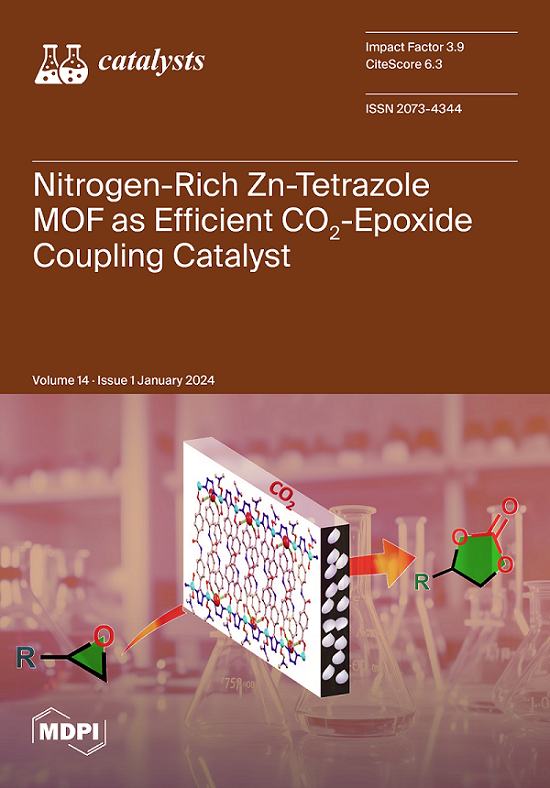可见光驱动的 BiOBr-TiO2-Attapulgite 光催化剂对多种黄原酸盐具有优异的光催化活性
IF 4
3区 化学
Q2 CHEMISTRY, PHYSICAL
引用次数: 0
摘要
采用简单的水热法和水浴法合成了新型三元复合材料 BiOBr-TiO2-attapulgite (BTA),对多种黄原酸盐具有优异的光催化性能。在 BTA 光催化剂中,TiO2 和 BiOBr 被均匀地负载在酸活化的阿塔蓬石表面。乙基黄原酸钠(SEX)是采矿过程中广泛使用的一种捕集剂,由于其毒性较高,因此被选为目标污染物。与 TiO2 纳米颗粒、BiOBr 纳米片和 BiOBr-TiO2 异质结相比,BTA 三元光催化剂的吸附和光催化降解性能明显更高。结构表征和实验结果表明,BTA 的优异光催化降解效率主要归功于 BiOBr 和 TiO2 之间形成的异质结,以及铁橄榄石提供的额外活性吸附位点。自由基清除实验和 EPR 结果证实,在整个实验过程中,光生成的空穴是光降解 SEX 的主要活性物种。液相色谱-质谱联用(LC-MS)结果为了解 SEX 的潜在降解途径提供了依据。这项研究表明,BTA 作为一种新型三重复合材料,可在 20 分钟内快速完全降解 20 mg/L SEX。这项研究提出了一种合成矿物基光催化剂的新方法,在气浮废水处理中具有广阔的应用前景。本文章由计算机程序翻译,如有差异,请以英文原文为准。
Visible-Light-Driven BiOBr-TiO2-Attapulgite Photocatalyst with Excellent Photocatalytic Activity for Multiple Xanthates
The novel ternary composites BiOBr-TiO2-attapulgite (BTA) were synthesized using a simple hydrothermal and water-bath method, exhibiting excellent photocatalytic performance to multiple xanthates. For the BTA photocatalyst, TiO2 and BiOBr were uniformly loaded onto the surface of acid-activated attapulgite. As a widely used collector in mining processes, sodium ethyl-xanthate (SEX) was selected as the target pollutant due to its high toxicity. The BTA ternary photocatalyst demonstrated significantly higher adsorption and photocatalytic degradation performance compared to TiO2 nanoparticles, BiOBr nanosheets, and BiOBr-TiO2 heterojunction. Structural characterization and experimental results indicated that the exceptional photocatalytic degradation efficiency of BTA was mainly attributed to the formation of a heterojunction between BiOBr and TiO2, as well as the presence of additional active adsorption sites provided by attapulgite. Free radical scavenging experiments and EPR results confirmed that the photogenerated holes were the predominant active species in photodegrading SEX throughout the entire experiment. The LC-MS results provided insight into potential degradation pathways of SEX. This research demonstrates that BTA, as a novel triple composite material, achieves rapid and complete degradation to 20 mg/L SEX within 20 min. This work presents a novel approach to synthesize mineral-based photocatalysts, which have broad prospects for application in flotation wastewater treatment.
求助全文
通过发布文献求助,成功后即可免费获取论文全文。
去求助
来源期刊

Catalysts
CHEMISTRY, PHYSICAL-
CiteScore
6.80
自引率
7.70%
发文量
1330
审稿时长
3 months
期刊介绍:
Catalysts (ISSN 2073-4344) is an international open access journal of catalysts and catalyzed reactions. Catalysts publishes reviews, regular research papers (articles) and short communications. Our aim is to encourage scientists to publish their experimental and theoretical results in as much detail as possible. Therefore, there is no restriction on the length of the papers. The full experimental details must be provided so that the results can be reproduced.
 求助内容:
求助内容: 应助结果提醒方式:
应助结果提醒方式:


